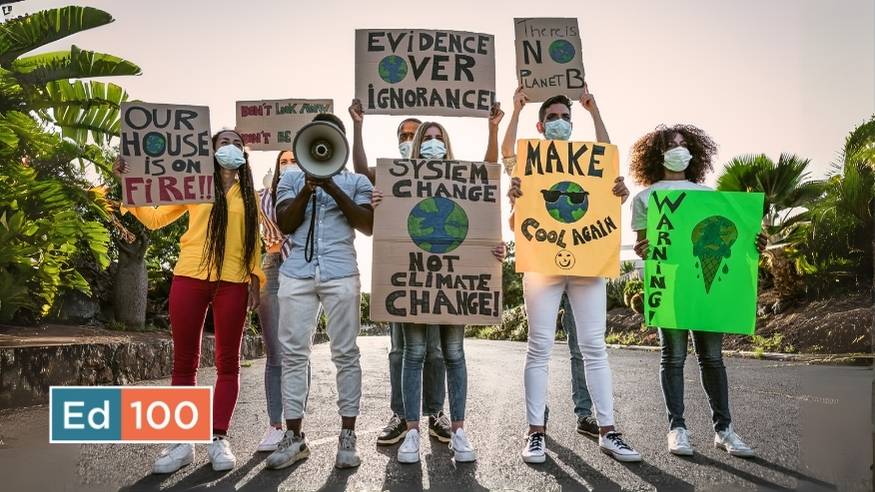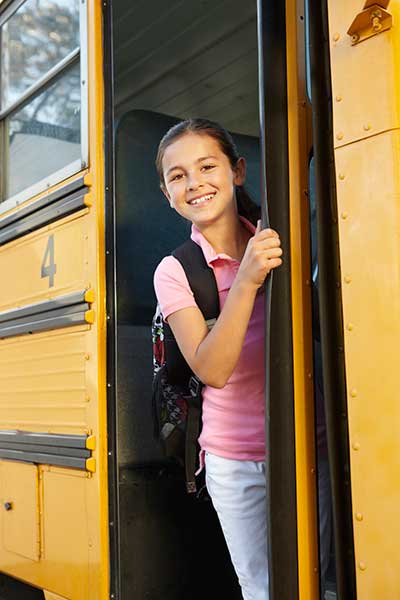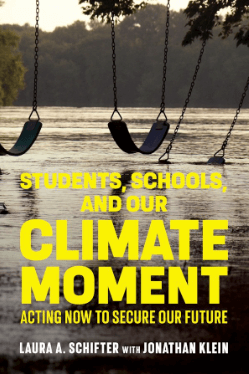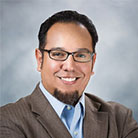Schools vs. Climate Change

Five facts and ten words for school communities
California students know they are living in a changing climate. Across the state, their classes have been cancelled due to smoke-filled air. In Monterey County, their schools were flooded. At least a dozen schools in Los Angeles County were damaged by wildfires in January, 2025. Five were destroyed completely.
Young people are both aware of climate change and deeply anxious about the implications for their futures. Ironically, the subject is largely absent from their classrooms — and from school priorities more broadly.
Yes, schools have many other pressing issues to deal with, from funding shortfalls and teacher shortages to achievement gaps and student mental health challenges. In addition, the subject of climate change is both complicated and potentially controversial.
So why should schools care about climate change?
A recently published book, Students, Schools, and our Climate Moment, answers that question and provides a blueprint for taking climate action within the school context. The authors, Laura Schifter and Jonathan Klein, highlight the stories of students, educators, and community members who are succeeding in making climate conversations more commonplace and actions more effective. School board members and schoolsite council participants should consider including it in their summer reading list.
Climate change can be explained simply
Most experts agree that step number one in addressing the issue of climate is to talk about it. To help all of us do that, the Yale Program on Climate Change Communication has boiled down the consensus to “five facts and ten words about climate change.”
- It’s real.
- It’s us.
- It’s bad.
- Scientists agree.
- There’s hope.
Our global predicament offers profound opportunities for teaching and learning. For example, the scientific aspects of climate change involve chemistry, biology, geology and industry. About 450 million years ago, plants evolved the neat trick of using energy from the sun to grow stalks and fronds, capturing carbon from the air to make lignin. Eventually, fungi and other organisms developed the capacity to consume lignin and unlock the energy from it. But for a temporary period of many millions of years (especially the carboniferous period), lignin wasn't biodegradeable. Like plastics today, it could break up, but it didn't rot. For eons, it piled up and gradually compressed into layers of coal and seeps of petroleum.
The heart of the climate problem today is that since the dawn of the industrial revolution, humans have been rapidly burning 60 million years’ worth of fossilized carbon back into the atmosphere all at once. Natural, gradual processes can’t keep up. The sudden, massive burst of burned carbon has unbalanced the civilization-friendly climate that humans have enjoyed and taken for granted for more than 10,000 years, raising global temperatures and creating much greater volatility in the natural environment. To be clear, the planet isn’t at risk, but modern civilization certainly is.
We have become used to a way of life that relies on burning fossilized energy. That includes our energy use, transportation, buildings, manufacturing, food production, and land use. School communities can no longer afford to ignore the effects, including:
- Pervasive, unrelenting extreme weather events;
- Health dangers, particularly for children, which begin as early as pregnancy and can be especially dangerous because of children’s ongoing physical and behavioral development;
- Learning loss caused by school closures, physical and mental health issues, and extreme heat in school buildings; and
- The disproportionate effect on low-income rural and urban communities due to their location, lack of green space, and limited resources.
In their book, Schifter and Klein explore evidence about how these factors matter to children and schools. They also provide hope by clearly describing the types of actions that schools across the country are taking to make a difference.
Schools are essential to the solutions
As Ed100 calls out, education requires places for learning. We count on school districts to provide safe spaces where educators can prepare children for the future. Schifter and Klein share powerful stories from school and community leaders, as well as students, about ways to address climate change through mitigation, adaptation and education:
Mitigation: Reduce the warming. Schools are among the largest energy consumers in the public sector. To reduce their climate impact, schools must rethink how they get power, heat and cool buildings, transport students, source food, and manage waste.
Adaptation: Buffer the effects of climate change. School districts and site councils can and should assess how increased climate risks (think wildfires, floods and extreme heat for example) might impact learning and their wider community. With that understanding, they can think strategically about how to prepare for instability and make their buildings and operations less vulnerable.
Education: Prepare young people. A 2022 survey about climate change reported that eight out of ten respondents agreed “Children will be essential in fighting climate change and we must give them the knowledge and skills to build a sustainable world.” Education about climate change varies by locale, and can be hampered by teacher confidence and knowledge. Fortunately, in California, environmental literacy is part of our curricular standards and several organizations are working to support teaching across subject areas, including creation of a new K-12 curriculum strand that addresses climate change directly.
Schifter and Klein underscore that all of these efforts need to recognize that climate change “is a threat multiplier that amplifies existing patterns of injustice within society.” Thus “school districts must bring an equity and justice focus to making decisions and allocating resources throughout these priorities.”
This Is Planet Ed provides a comprehensive guide for this work.
Everyone has a role to play
In many school districts, energy is the largest ongoing cost of operations after the cost of salaries and benefits. Measures that make heating, cooling and transportation more efficient can free up money for education. School district leaders and teachers are well-positioned to make a difference in climate change mitigation, adaptation, and education.
At home, families can model sustainable behaviors, learn about and discuss climate issues, and participate in local eco-friendly activities. As public school advocates, PTAs can encourage school officials and school boards to adopt climate-conscious policies and practices. Meanwhile, students are often the most credible and effective voices calling for climate action within their schools and communities.
Toolkits from This Is Planet Ed provide great starting points for educators, school board members, families, parent activists, and students to build from interest to action.
It’s Urgent
School communities are an essential and underappreciated component of the climate fight. In Students, Schools, and Our Climate Moment, the authors emphasize that “action on climate change over the next decade is essential to avoid its most devastating impacts.”
“Tapping into the power of education to model solutions, foster resilience, and empower young people with the needed knowledge, skills, and mind-sets can help build a brighter future. Building that future depends on us all now working together, learning, and committing to act.”
To learn more about the connections between schools, students and climate, read this new book and explore the links above. Then share what you learn and pick a place to start taking action. Particularly if your school buildings are old and/or uncomfortable, it’s vital to start planning as soon as possible for climate-friendly options. A poor choice of heating/cooling systems could lock in climate damage for a long time.
About the authors of Students, Schools, and Our Climate Moment:
- Laura Schifter is a senior fellow at the Aspen Institute, where she founded and directs This Is Planet Ed, an initiative to unlock the power of education as a force for climate action.
- Jonathan Klein is co-founder and CEO of UndauntedK12, which works to support public schools in California and nationally to make an equitable transition to zero carbon emissions.
Tags on this post
Facilities Health Student voiceAll Tags
A-G requirements Absences Accountability Accreditation Achievement gap Administrators After school Algebra API Arts Assessment At-risk students Attendance Beacon links Bilingual education Bonds Brain Brown Act Budgets Bullying Burbank Business Career Carol Dweck Categorical funds Catholic schools Certification CHAMP Change Character Education Chart Charter schools Civics Class size CMOs Collective bargaining College Common core Community schools Contest Continuous Improvement Cost of education Counselors Creativity Crossword CSBA CTA Dashboard Data Dialogue District boundaries Districts Diversity Drawing DREAM Act Dyslexia EACH Early childhood Economic growth EdPrezi EdSource EdTech Education foundations Effort Election English learners Equity ESSA Ethnic studies Ethnic studies Evaluation rubric Expanded Learning Facilities Fake News Federal Federal policy Funding Gifted Graduation rates Grit Health Help Wanted History Home schools Homeless students Homework Hours of opportunity Humanities Independence Day Indignation Infrastructure Initiatives International Jargon Khan Academy Kindergarten LCAP LCFF Leaderboard Leadership Learning Litigation Lobbyists Local control Local funding Local governance Lottery Magnet schools Map Math Media Mental Health Mindfulness Mindset Myth Myths NAEP National comparisons NCLB Nutrition Pandemic Parcel taxes Parent Engagement Parent Leader Guide Parents peanut butter Pedagogy Pensions personalized Philanthropy PISA Planning Policy Politics population Poverty Preschool Prezi Private schools Prize Project-based learning Prop 13 Prop 98 Property taxes PTA Purpose of education puzzle Quality Race Rating Schools Reading Recruiting teachers Reform Religious education Religious schools Research Retaining teachers Rigor School board School choice School Climate School Closures Science Serrano vs Priest Sex Ed Site Map Sleep Social-emotional learning Song Special ed Spending SPSA Standards Strike STRS Student motivation Student voice Success Suicide Summer Superintendent Suspensions Talent Teacher pay Teacher shortage Teachers Technology Technology in education Template Test scores Tests Time in school Time on task Trump Undocumented Unions Universal education Vaccination Values Vaping Video Volunteering Volunteers Vote Vouchers Winners Year in ReviewSharing is caring!
Password Reset
Search all lesson and blog content here.
Login with Email
We will send your Login Link to your email
address. Click on the link and you will be
logged into Ed100. No more passwords to
remember!






 Mary Perry has served in many leadership roles in the California State PTA, including as a representative to the Climate Ready Schools Coalition. She previously worked as Deputy Director of EdSource and then as an independent education consultant, helping to explain education policy, data, and research to a wide range of education stakeholders, including parents and student leaders.
Mary Perry has served in many leadership roles in the California State PTA, including as a representative to the Climate Ready Schools Coalition. She previously worked as Deputy Director of EdSource and then as an independent education consultant, helping to explain education policy, data, and research to a wide range of education stakeholders, including parents and student leaders.









Questions & Comments
To comment or reply, please sign in .
Jeff Camp - Founder May 28, 2025 at 2:23 pm